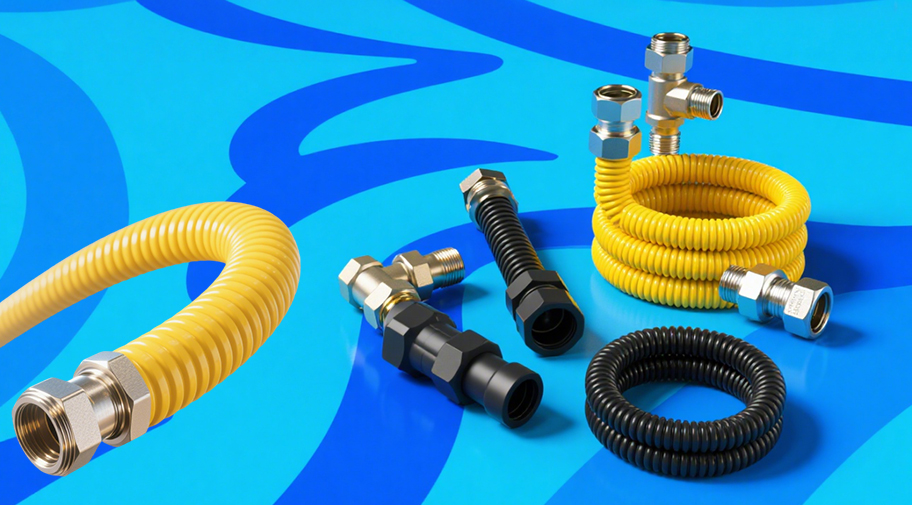-
+86-574-62166708
-
-









In gas transmission systems, the safety, sealing performance, and stability of pipelines are directly related to the normal operation of the system and personnel safety. Whether it is industrial gases (such as oxygen, nitrogen, hydrogen), fuel gases (natural gas, liquefied petroleum gas), or special gases (such as corrosive gases, high-purity gases), the requirements for transmission pipelines are extremely strict. Stainless steel bellows, with their unique material and structural advantages, can effectively solve problems such as leakage, corrosion, and vibration impact faced by traditional pipelines in gas transmission, making them an ideal choice for gas systems. The following elaborates on specific solutions from multiple dimensions.
Precise Matching of Core Performance Advantages with Gas System Requirements
The core requirements of gas systems for pipelines are absolute sealing, resistance to gas corrosion, resistance to vibration and impact, adaptability to pressure fluctuations, and cleanliness control. The characteristics of stainless steel below can perfectly meet these requirements:
Extreme Sealing Performance: Adopting integrally formed 304, 316, and other stainless steel materials, the bellows and connecting ends (such as threads, flanges) achieve tight cooperation through precision machining, which can realize metal-to-metal hard sealing or be matched with special seals (such as copper gaskets, PTFE gaskets) to ensure zero gas leakage. For high-pressure gas systems (with working pressure up to 10MPa or more), its sealing reliability is far to rubber hoses or ordinary metal pipelines, and the leakage rate can be controlled below 1×10¹⁰ Pa·m³/s.
Excellent Gas Corrosion Resistance: 304 stainless steel can withstand long-term erosion by dry gases (such as oxygen, nitrogen) and non-corrosive fuel gases; 316 stainless steel, due to its molybdenum content, can resist corrosion by sulfur-containing fuel gases, chlorine gas, hydrogen fluoride, and other corrosive gases, avoiding the formation of holes or impurity shedding on the inner wall of the pipeline caused by erosion, thus ensuring the purity of gas transmission.
Vibration and Pressure Fluctuation Resistance: The annular corrugated structure of the bellows has good elasticity, which can absorb vibrations and pressure pulses generated by compressor operation and valve opening/closing in the gas system, reduce stress concentration at pipeline interfaces, and lower the risk of loose leakage caused by rigid connections. It is especially suitable for connecting parts between gas compressors, storage tanks, and pipelines.
Cleanliness Adaptability: After electrolytic polishing of the inner wall, the surface roughness Ra can be as low as 0.8μm or less, which is not easy to adsorb impurities or moisture in the gas, and no particles fall off. It meets the transmission requirements of high-purity gases (such as ultra-high purity nitrogen used in the electronics industry, special gases used in semiconductor manufacturing) and avoids gas pollution affecting production quality.
Wide Temperature and Pressure Adaptability: It can work stably in the temperature range of -200℃ to 450℃, adapting to the vaporization transmission of low-temperature liquefied gases (such as liquid nitrogen, liquid oxygen) and high-temperature gas systems; the working pressure covers from vacuum to 30MPa, which can not only meet the needs of low-pressure fuel gas pipelines (below 0.1MPa) but also be used in high-pressure industrial gas transmission systems.
Typical Application Scenarios
Stainless steel bellows can specifically solve transmission problems in different types of gas systems:
Industrial Gas Transmission Systems
Used for pipeline connection of inert gases such as oxygen, nitrogen, and argon, especially in welding workshops and metal processing fields. The vibration resistance of bellows can reduce the leakage risk at the connection between oxygen cylinders and pipelines.
In hydrogen transmission systems, 316 stainless steel material can avoid hydrogen embrittlement, and with a special sealing structure, it can prevent explosion hazards caused by hydrogen leakage.
For the transmission of corrosive industrial gases (such as chlorine gas, sulfur dioxide), 316L stainless steel bellows are selected to resist corrosion of the pipeline by gases and ensure the long-term safe operation of the system.
Gas Supply Systems
For indoor and outdoor pipeline connection of urban natural gas and liquefied petroleum gas, bellows are used between gas meters, valves, and main pipelines. Their flexible compensation can reduce interface leakage caused by pipeline displacement due to building settlement or temperature changes.
For gas branch pipes in commercial kitchens and industrial kilns, the temperature resistance of bellows can adapt to the high-temperature environment near stoves, and their anti-aging performance avoids cracking and leakage of rubber hoses due to long-term use.
Special Gas and High-Purity Gas Systems
For the transmission of high-purity gases (such as ultra-high purity ammonia, silane) in the semiconductor and photovoltaic industries, bellows with electrolytically polished inner walls can reduce contact pollution between gases and pipelines, ensuring gas purity (reaching 99.9999% or more);
For laboratory gas pipelines (such as carrier gases for gas chromatographs, special gases for spectral analysis), the low adsorption of bellows ensures the stability of gas components and improves the accuracy of experimental data.
Connection of Gas Storage and Processing Equipment
For the connection between gas storage tanks, cylinders, and vaporizers, pressure reducing valves, bellows can absorb vibrations during equipment operation and protect the sealing performance of valve interfaces;
For the connection between the liquid outlet pipe of low-temperature gas (such as liquid nitrogen, liquid argon) storage tanks and vaporizers, bellows can adapt to temperature changes from low temperature to normal temperature, avoiding cracks in pipelines due to thermal expansion and contraction.
Key Selection Points and Installation Specifications
1. Scientific Selection
Material Selection: Determine the material according to gas properties - 304 stainless steel is selected for inert gases and fuel gases; 316/316L stainless steel is selected for corrosive gases and fuel gases in seawater environments; low-carbon stainless steel (such as 316L) with electrolytically polished inner walls is required for high-purity gas systems.
Caliber and Pressure Rating: Select DN6-DN200 calibers according to gas flow. The working pressure must match the system design pressure (for example, 1.6MPa rating is usually selected for gas systems, and a 6.4MPa or higher rating is selected for industrial high-pressure gases).
Connection Method: Threaded connection (with gas-specific sealant) is commonly used in gas systems; flange connection (with O-ring seal) is mostly used in industrial gas systems; VCR face seal joints are selected for high-purity gas systems to ensure zero leakage and cleanliness.
Length and Compensation Amount: Determine the length according to pipeline displacement requirements, and reserve axial or lateral compensation allowance (usually the compensation amount does not exceed 10% of the effective length of the bellows) to avoid affecting the seal due to excessive stretching or compression.
2. Installation Specifications
Fire Prohibition and Cleaning Treatment: Before installing the gas system, ensure that there are no impurities in the pipeline to avoid sparks during installation; before installing the high-purity gas system, clean the inner wall of the bellows with absolute ethanol to remove oil stains and particles.
Bending and Fixing: During installation, the bending radius should not be less than the value specified by the product (usually 5-8 times the pipe diameter), and forced twisting is prohibited; fixed brackets are set every 1.5-2 meters in the straight section, and guide brackets are added at both ends of the bending section to prevent deformation caused by the self-weight of the pipeline.
Sealing Surface Protection: Before connection, check the flatness of flange faces and threaded interfaces, and remove burrs and scratches; apply gas-specific sealant corresponding to the gas during threaded connection (such as PTFE sealing tape for gas), and select gaskets compatible with the gas for flange connection (such as oil-resistant rubber gaskets for gas, PTFE gaskets for corrosive gases).
Leakage Detection: After installation, leakage testing must be carried out - soap water is applied to interfaces for bubble detection in gas systems; helium mass spectrometers are used in industrial gas and high-purity gas systems to ensure that the leakage rate meets system requirements (such as the leakage rate of high-purity gas systems ≤1×10⁻¹¹ Pa·m³/s).
Application Benefits
Improve System Safety: Compared with traditional galvanized steel pipes or rubber hoses, the leakage risk of stainless steel bellows is reduced by more than 95%, especially in gas systems with flammable and explosive gases such as fuel gas and hydrogen, which can significantly reduce potential safety accidents.
Prolong Service Life: Stainless steel materials are anti-aging and corrosion-resistant, with a service life of more than 20 years, far exceeding that of rubber hoses (1-3 years) and ordinary steel pipes (8-10 years), reducing replacement frequency and maintenance costs.
Ensure Gas Purity and Quality: In high-purity gas systems, it can avoid product scrapping caused by pipeline pollution (such as defects in semiconductor chips caused by impure gases) and reduce production losses.
Adapt to Complex Working Conditions: The flexible compensation capability solves the impact of building settlement, equipment vibration, and temperature changes on pipelines, reduces shutdown maintenance caused by pipeline damage, and improves the stability of system operation.
Summary
Through material adaptation, structural optimization, and precision machining, stainless steel bellows achieve comprehensive performance of "safe sealing, corrosion resistance and durability, and clean transmission" in gas systems. Whether it is conventional industrial gases, civil fuel gases, or high-demand special gas systems, they can provide reliable transmission solutions, providing a solid guarantee for the safe and stable operation of gas systems.